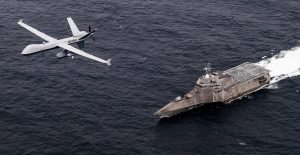The U.S. Navy’s research arm has released a strategy for developing intelligent autonomous systems and integrating them with the fleet.
Despite splashy Trump administration plans to build a 355-ship fleet and general bipartisan agreement that the U.S. fleet should be larger, the U.S. Navy is struggling to build up its numbers. Meanwhile, the Chinese navy surpassed the U.S. Navy in raw numbers – though not tonnage – in 2019 and continues to grow, commissioning increasingly capable warships and building up its own carrier fleet, a traditional area of U.S. superiority. To blunt China’s numerical advantages in a potential conflict, the U.S. Navy has increasingly looked to unmanned craft to supplement its traditional ships and submarines.
In the last weeks of the Trump administration, the Pentagon released an ambitious, and unfunded, plan for an enormously expanded navy by 2045 that included more than 200 unmanned ships and submarines. While many of those unmanned craft would likely still be controlled remotely by crews of operators, the navy is increasingly thinking about how to use advances in machine learning and artificial intelligence to provide autonomous control.
The strategy wants intelligent autonomous systems to provide several advantages. Large numbers of smaller systems can complement traditional manned systems and enable more effective distributed operations, which the navy sees as key to leveraging its comparatively smaller fleet. Intelligent machines can also adapt to changing environments and by acting as persistent sensors and network hubs, can help the U.S. Navy overcome an adversary’s efforts to deny U.S. forces the use of traditional informational and sensor advantages. Finally, being unmanned, these systems can be used in environments where the risk to manned platforms is too great.
The strategy asserts that fleets and swarms of autonomous vehicles will “create superiority in peacetime and wartime operations.” Successfully integrated autonomous systems can provide key advantages in a conflict, but beyond providing sensor and networking capability in peacetime, their contribution to deterring that conflict is murkier.
In 2019, Iran shot down a U.S. drone that was patrolling over international waters off its coast. Iran likely felt emboldened to fire on the drone because it did not risk harm to a human pilot, and the U.S. response was challenged as a result. If a human pilot had been killed, it is likely that the U.S. would have launched retaliatory strikes against Iran. Trump wanted to respond forcefully and U.S. forces were reportedly preparing to strike a number of targets including radar and missile sites, but the mission was called off at the last minute because they would have likely killed Iranian personnel, violating rules and conventions about the proportionality of force.
Earlier this year, the U.S. Navy conducted its first large exercise designed to integrate unmanned systems with the fleet, using an advanced Zumwalt-class destroyer as a mothership, and is perfecting the use of large unmanned surface vessels. The unmanned surface ships are envisioned to provide supplemental missile launchers for manned warships, but the navy emphasizes that however much autonomous technology is integrated into its unmanned systems, the use of lethal weapons will still be controlled by a human operator.
































